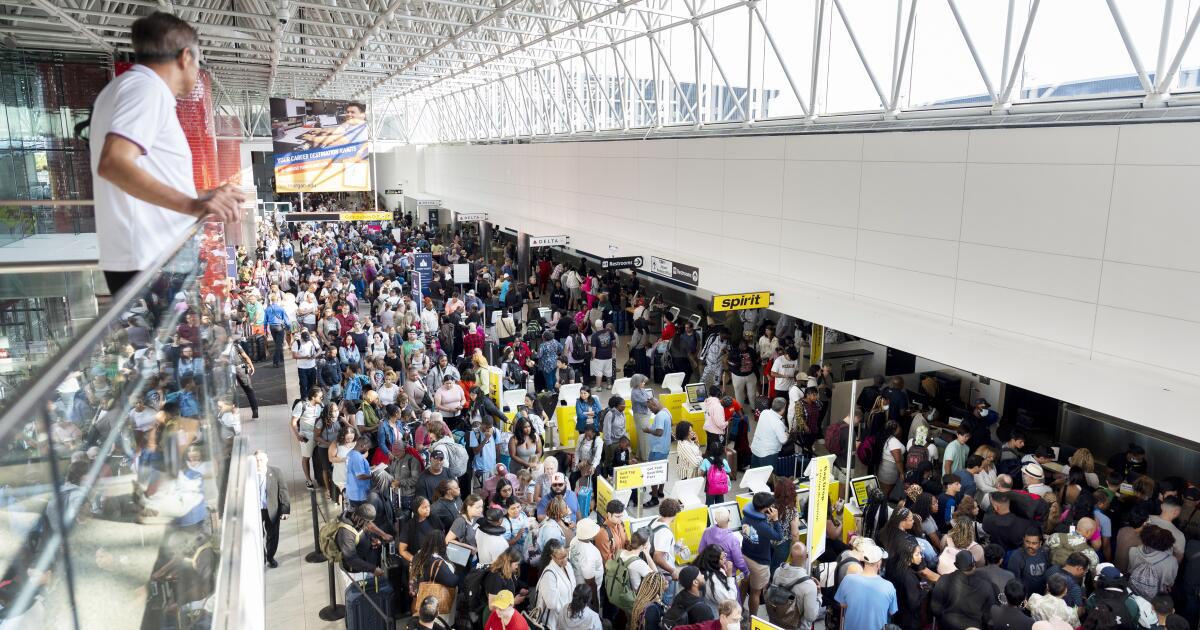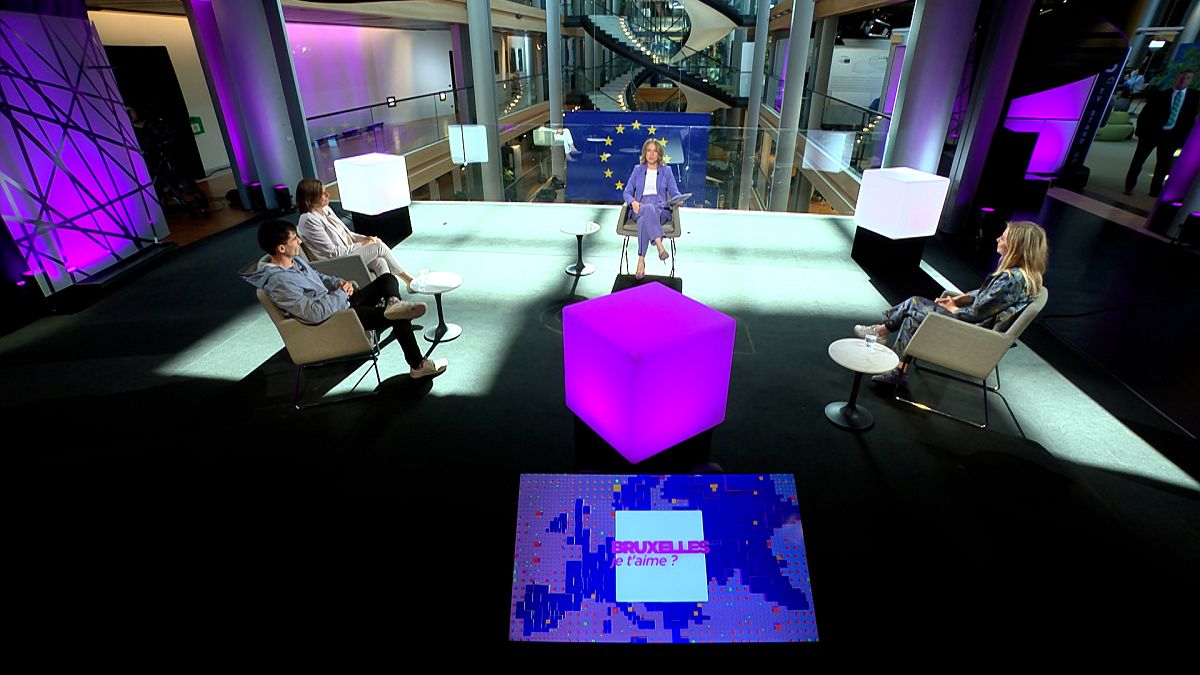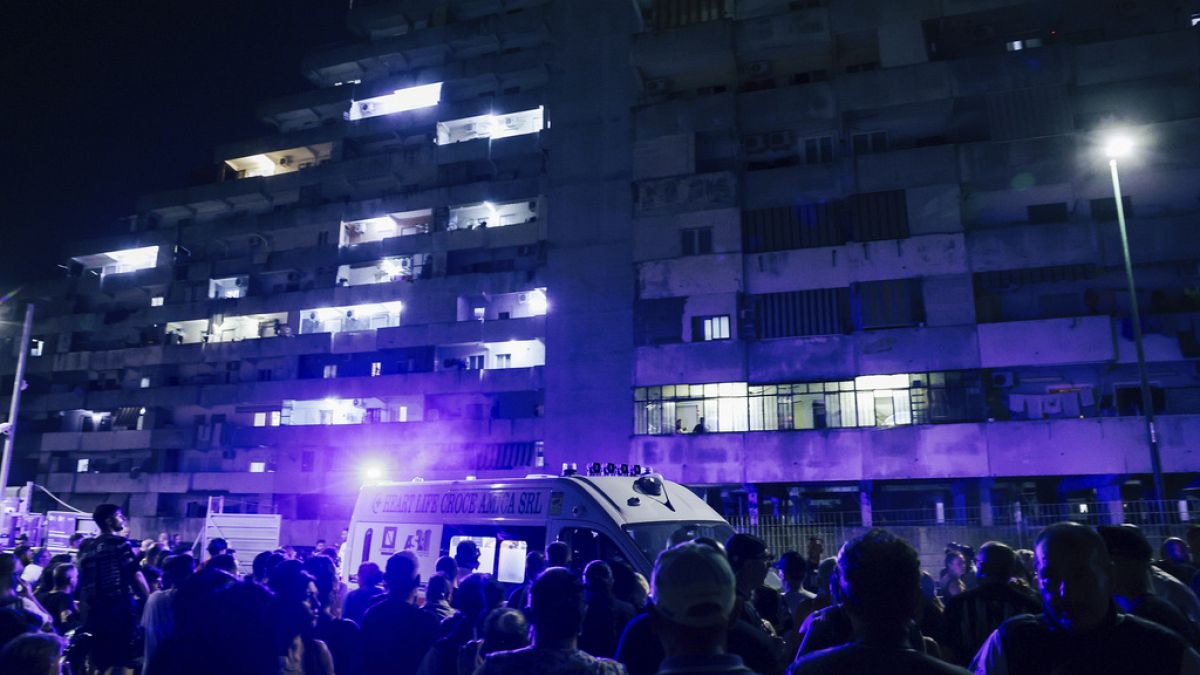Business
Travelers Delayed or Stuck by the CrowdStrike Outage: What Did Your Airline Provide?
The flight disruptions brought on by the global I.T. failure were deemed within the control of the airlines, meaning airlines have to reimburse passengers for meals, transportation and hotels. Did your carrier live up to the requirement?

Business
Video game performers move closer to strike as SAG-AFTRA negotiations stall over AI

Video game actors are inching closer to a walkout as performers union SAG-AFTRA and the top video game companies struggle to reach a deal on contract terms related to artificial intelligence.
The Screen Actors Guild-American Federation of Television and Radio Artists announced over the weekend that its national board has granted its national executive director and chief negotiator, Duncan Crabtree-Ireland, the authority to call a strike if the union cannot obtain a settlement with the companies.
The announcement comes nearly a year after more than 30,000 union members voted 98% in favor of authorizing a strike while bargaining for a new Interactive Media Agreement.
The contract expired in November 2022 and covers about 2,600 performers doing voice and motion-capture work in the video game industry.
“Our resolve is unwavering and should not be tested,” Crabtree-Ireland said in a statement.
“We are steadfast in our commitment to our membership who work this contract and whose extraordinary performances are the heart and soul of the world’s most popular video games. Time is running out for the companies to make a deal.”
Crabtree-Ireland pressured video game producers to bring forth an offer that includes significant gains for performers, especially in the realm of AI. Game performers contend that they are particularly vulnerable to AI because many of them specialize in voice-over work.
“We are continuing to negotiate in good faith and have reached tentative agreements on the vast majority of proposals,” Audrey Cooling, a spokesperson for the video game producers, said in a statement.
“Based on that progress, we remain optimistic that a deal is within reach.”
The latest move by SAG-AFTRA comes about a year after TV and movie actors staged a strike that lasted 118 days. AI was also a major sticking point in that labor dispute.
The last time game actors went on strike was in October 2016.
Video game workers are seeking a contract that would require producers to get their consent before reproducing their voices or likenesses with AI. They are also demanding compensation when AI is used to replicate their performances.
Additionally, the performers are looking for wage increases to keep up with inflation, more rest time and set medics for stunts and hazardous jobs.
Former Times staff writer Sarah Parvini contributed to this report.
Business
Column: The CrowdStrike meltdown reminds us that the hacking problem doesn't come only from outside

Just last Wednesday, I posted a column reporting how our richest corporations, through sheer miserliness and profit-seeking, left millions of Americans vulnerable to technological attacks on their privacy and welfare.
I failed to raise one important question: What if the attacks come from inside the house?
That’s exactly what happened Friday. An ineptly designed update to a program rolled out by the cybersecurity company CrowdStrike and installed automatically on users’ machines instantly crashed millions of computers running Microsoft programs and left them disabled until manual fixes could be undertaken. Some haven’t been fixed yet.
Crowdstrike seemingly borrowed Boeing’s approach to quality control.
— Business blogger Ed Zitron
The fallout reached worldwide and affected people across the modern technological landscape. Thousands of flights were canceled. Doctors couldn’t perform surgeries. Banking transactions were frozen. Emergency 911 lines went silent.
The affected computers displayed what Microsoft Windows users know as the dreaded “blue screen of death.” Typically, this is a baby-blue screen bearing the message that Microsoft’s operating system hadn’t loaded correctly and the machine should be restarted.
That didn’t work this time: The errant CrowdStrike application was burrowed so deep within the Microsoft operating system — as it’s designed to do — that every time a machine restarted, it ran into the same glitch and went dead again in an infinite doom loop.
The CrowdStrike program — irony of ironies — is an anti-hacking application that identifies hacking attempts and fights them off. In the cat-and-mouse game pitting computer users against hackers, such applications have to be updated regularly. They reside in the bowels of the operating system, because in order to be effective, they have to load before almost any other function.
In this case, a coding error in the update delivered an order to the operating system that caused the system to shut down.
That’s a simplified explanation of what happened. Now let’s look at the lessons this episode teaches us — if we’re willing to learn them.
They have to do with our complacency about our dependence on digital systems, including those distributed by developers we’ve never heard of (CrowdStrike, for instance).
What few people are aware of as they go about their lives is how much crucial digital infrastructure is based on Microsoft programs and applications, and how much of those are supplemented by third-party programs and applications.
All of this must work together to work smoothly — or to appear to work smoothly. Here and there something goes wrong, but its ramifications are sufficiently constrained that it can be rectified quickly, and even invisibly.
A great deal of it, furthermore, is automated; it’s designed to run with a minimum of human intervention. In the view of the IT departments that are expected to monitor all this, humans are perpetual money pits — they need days off, get sick, demand raises, quit and must be replaced by newbies needing training, etc., etc. By comparison, machines look like a one-time capital expense — set it and forget it, is the goal.
Microsoft is the hub of these networks because Microsoft made them its business. It created an open architecture for third-party developers to piggyback on; the fundamental idea was that by extending the system’s capabilities, those other developers made Microsoft’s central system more valuable. Microsoft either outsourced some functions to independent developers, or allowed them to design applications that competed with Microsoft’s versions — but those still were designed to work with Microsoft operability.
Among those developers is Austin, Texas-based CrowdStrike, one of countless firms offering cybersecurity services to Windows users. (Microsoft’s own cybersecurity suite is known as Defender.)
Apple computers and devices don’t have the same vulnerabilities because that company does almost all its extensions in-house, and keeps a very close eye on what it allows to interact with its software and hardware; the company doesn’t allow outside applications to interact with its operating system at the fundamental level available with Microsoft’s systems.
But Apple doesn’t have anywhere near as large a footprint in enterprise services as Microsoft. A report issued in March by the government’s Cyber Safety Review Board about a major hacking intrusion into Microsoft’s cloud system in March 2023 asserted that the company’s “ubiquitous and critical products … underpin essential services that support national security, the foundations of our economy, and public health and safety.”
Anyone living in the modern world has to confront the drawbacks of our reliance on digital technology on almost a daily basis. In prehistoric days, back when our household appliances were mechanical or electric, not electronic, a breakdown was easy to diagnose and fix — switch out a tube or tighten a screw.
When a device ceases to function today, it’s often impossible to pinpoint the fault — did my TV go bad, or did the internet go down, or was it just the channel I was watching?
Yet many of us rely on a single company for multiple services. For example, I get my home phone service, broadband internet, and television/video (broadcast and cable channels and streaming) from a single provider. I don’t have much choice, since for most of these it’s the only provider in my neighborhood. But when it goes down, everything goes down.
That provider, Spectrum, has tried to sell me on its mobile phone service too. I’ve refused, because I figure I need at least one thread of access to the outside world that isn’t dependent on its all-in-one monopoly.
Microsoft’s near-dominance of cloud computing — the ecosystem through which all those enterprise computers that went dead last week communicate with each other and with the outside world — should make all of us queasy, because the company’s cybersafety record is atrocious.
The Cyber Safety Review Board investigation concluded that the March 2023 hack occurred because “Microsoft’s security culture was inadequate and requires an overhaul, particularly in light of the company’s centrality in the technology ecosystem and the level of trust customers place in the company to protect their data and operations.”
The board mentioned, among other things, a “cascade of … avoidable errors” in the company’s cybersecurity program, its failure to detect the compromise by hackers of its own “cryptographic crown jewels,” but only acted after a customer — the U.S. State Department — discovered the incursion itself.
The board found that Microsoft’s security practices were inferior to those of “other cloud service providers.” The report mentioned Amazon, Google and Oracle as Microsoft rivals in cloud services with better security systems.
Microsoft pledged to “adopt a new culture of engineering security in our own networks” and said it had “mobilized our engineering teams to identify and mitigate legacy infrastructure, improve processes, and enforce security benchmarks.”
The CrowdStrike crash suggests that those efforts are still works in progress. It’s fair to say that much of the blame belongs to CrowdStrike, which allowed an update to a crucial application to be sent to users for automatic installation without doing the testing necessary to ensure that the update was operationally bulletproof.
Technology blogger Ed Zitron properly tied the disaster to the financialization of Big Business generally, in which pumping ever higher profits to shareholders becomes a higher priority than ensuring that one’s products meet quality standards.
“Crowdstrike seemingly borrowed Boeing’s approach to quality control,” Zitron wrote, “except instead of building planes where the doors fly off at the most inopportune times (specifically, when you’re cruising at 35,000ft), it released a piece of software that blew up the transportation and banking sectors, to name just a few.”
CrowdStrike Chief Executive George Kurtz moved promptly to “sincerely apologize” to all affected users, via a statement and an appearance on the NBC “Today” show. “We quickly identified the issue and deployed a fix, allowing us to focus diligently on restoring customer systems as our highest priority,” Kurtz said in a posting on the company’s website.
Microsoft placed the blame chiefly on CrowdStrike. “Although this was not a Microsoft incident, given it impacts our ecosystem, we want to provide an update on the steps we’ve taken with CrowdStrike and others to remediate and support our customers,” David Weston, a vice president for enterprise and security, wrote on the company’s website.
But Microsoft, plainly, failed to take on board the necessity of vetting every piece of third-party software that could have an effect on its own customers — before it blew up their computer systems.
No software system is immune from errors, especially now that they’re so complex and multilayered that not even their developers may know all their weak spots. (An error at Amazon’s cloud service incapacitated as many as 150,000 websites for several hours in February 2017 — a major problem, but not nearly on the scale of the CrowdStrike crash.)
But as these systems play an ever expanding role in modern life even as they become more complex, it’s incumbent on their providers to make security and safety their top priorities, not merely mouth the concept in marketing material without actually taking it seriously.
Cloud clients also need to pay more attention to what is getting automatically inserted into their systems. Who has the right to gloat over escaping the CrowdStrike meltdown last week? Amusingly, it’s Southwest Airlines. For decades, Southwest resisted Microsoft’s urgings that it upgrade its systems to the latest versions of Windows, relying on Windows 3.1, which is 32 years old — so antique that the CrowdStrike update wouldn’t even work on the airline’s systems.
So while affected carriers such as Delta, United and American had canceled nearly 2,400 flights by 6 p.m. Friday, Southwest had canceled three. (By midday Monday, the number of canceled flights reached beyond 12,300.) That doesn’t mean that Southwest gets everything right. After all, the airline suffered more than its competitors from the ferocious storm in December 2022 that snarled air traffic nationwide — precisely because it had not paid enough attention to keeping its computer systems updated.
In this case, however, Southwest’s cheapskate culture was its savior. That may only put it on the same level as the proverbial blind squirrel that occasionally finds a nut. But it shows that all of our Big Business squirrels need to keep their eyes open, and focused on the perils of inattention.
Business
Former owners of Sweet Lady Jane bakery, a celebrity favorite, settle wage theft lawsuit

The previous owners of bakery chain Sweet Lady Jane, facing “financial difficulty,” have settled a wage theft lawsuit brought by a former employee, according to court documents reviewed by The Times.
Details of the settlement between SLJ Wholesale LLC and Sweet Lady Jane LLC and Blanca Juarez, who worked at the bakery for about two months in 2022, are under seal.
The settlement addressed only Juarez’s individual claims. She alleged she was not compensated for all hours worked, including overtime, as well as for missed meal periods and rest breaks, according to a class-action lawsuit filed in June last year in Los Angeles County Superior Court.
Juarez and her legal counsel filed July 9 to dismiss her class-action lawsuit. An attorney for Juarez did not respond to a request for comment. Juarez could not be reached for comment.
Lawyers for the companies behind the bakery had denied Juarez’s allegations. The court filings did not name who owned the companies.
The companies maintained that Juarez and other employees who could join the lawsuit have been paid “all sums earned by them that are due.” It’s unclear whether more employees joined the suit.
Lawyers for the previous owners of Sweet Lady Jane did not respond to a request for comment about the settlement.
Juarez’s legal case was cast into doubt after the bakery abruptly closed its business on New’s Years Day, citing a lack of sales that prevented it from paying its “treasured employees,” according to a now-deleted Instagram post from January.
A note from the owners of Sweet Lady Jane bakery tells customers that they had decided to close their business in Santa Monica.
(Genaro Molina / Los Angeles Times)
Near a week after the closure, lawyers for the bakery submitted court documents that said the companies intend to file for a state alternative to bankruptcy, which could allow creditors, including former employees, to try to recover what they are owed.
Negotiations for a settlement to resolve Juarez’s individual labor code claims began around May, according to court documents. A copy of the settlement was filed to the state Labor and Workforce Development Agency on July 9.
Amid the legal battle, Sweet Lady Jane opened its doors for business again — this time under the ownership of Julie Ngu and Matt Clark.
The couple bought the bakery’s assets, including the recipes and brand name, in February, emphasizing in interviews that they “really, really, really want to make sure that everybody understands that we have nothing to do with the old owners.”

Tables are piled up against the front counter of Sweet Lady Jane in Santa Monica on Jan. 9, 2024.
(Genaro Molina / Los Angeles Times)
“We’re only as good as we treat our own people. … Our staff is our No. 1 priority,” Clark told The Times on Friday. “I’m glad that at least that chapter of the old ownership is over.”
-

 Politics1 week ago
Politics1 week agoTwo key states to see massive GOP voter registration operation
-

 News1 week ago
News1 week agoShooting at a Trump Rally in Pennsylvania: Maps and Photos
-

 World6 days ago
World6 days agoOne dead after car crashes into restaurant in Paris
-

 News5 days ago
News5 days agoVideo: Young Republicans on Why Their Party Isn’t Reaching Gen Z (And What They Can Do About It)
-

 News7 days ago
News7 days agoIn Milwaukee, Black Voters Struggle to Find a Home With Either Party
-

 News1 week ago
News1 week agoVideo: Biden Asks America to ‘Lower the Temperature’
-

 World1 week ago
World1 week agoUkraine: shelling in Kherson leaves at least two people dead
-

 World4 days ago
World4 days agoFreshers' week in Strasbourg for new EU lawmakers















